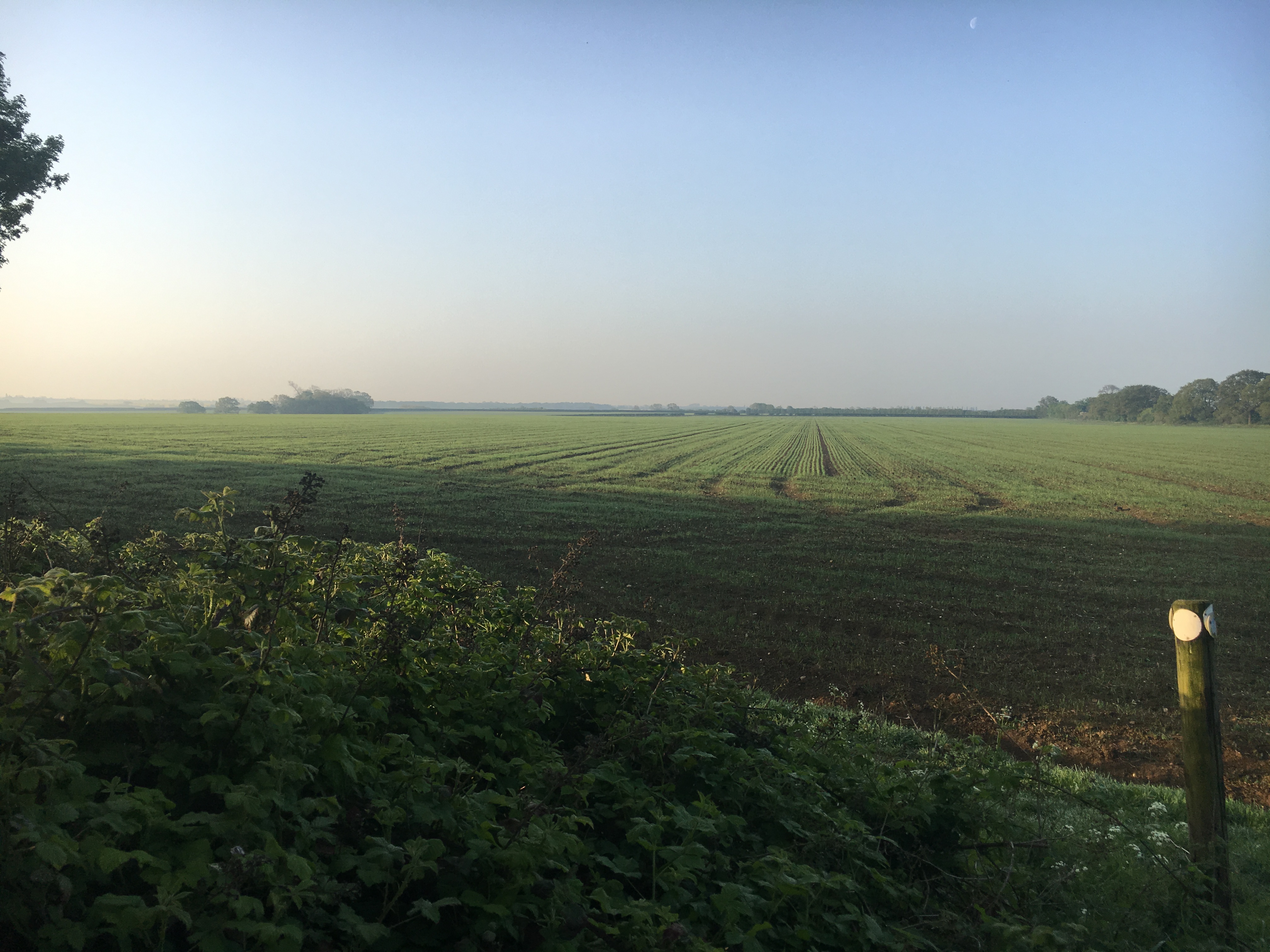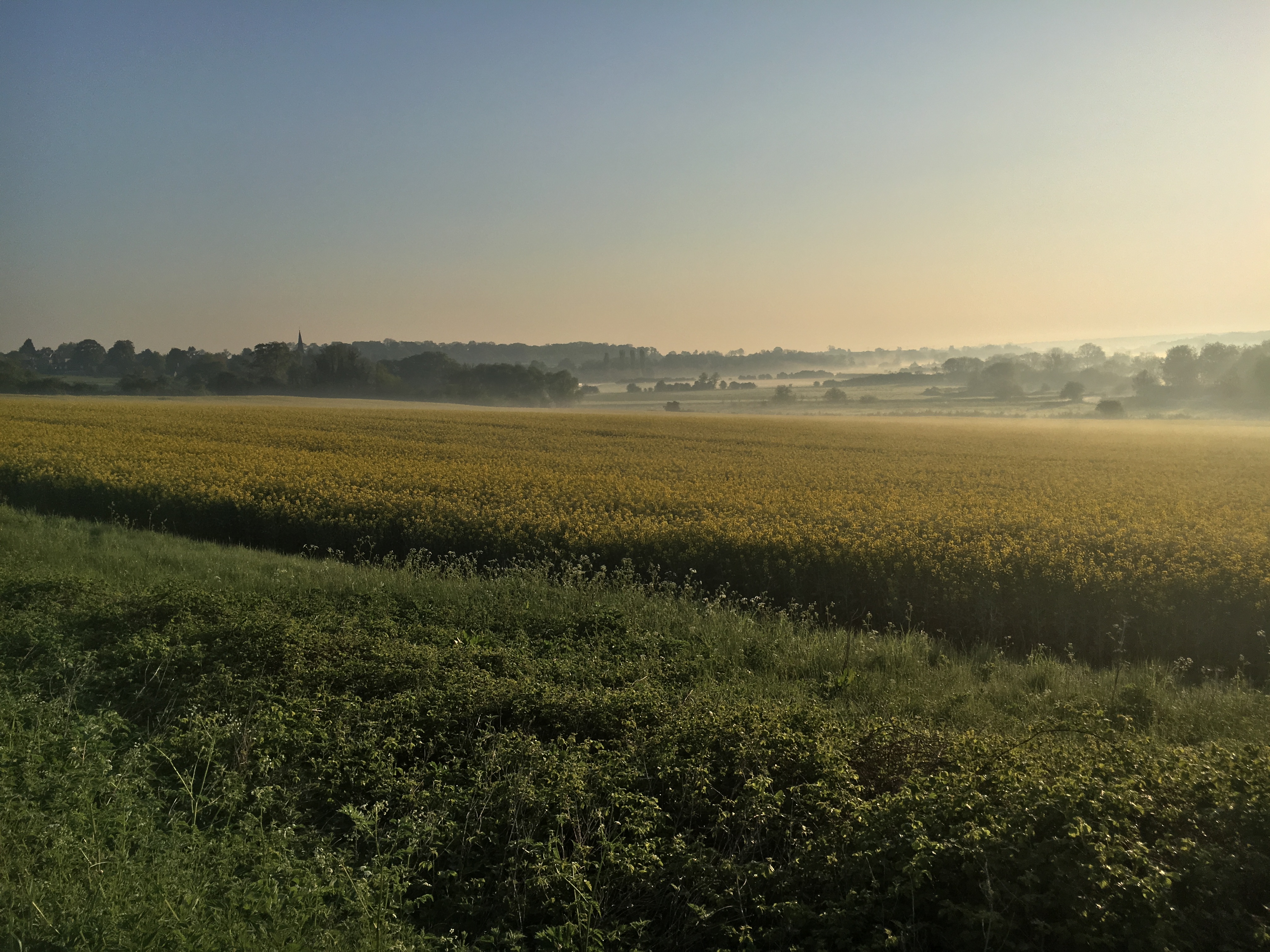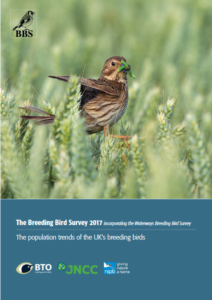
I did my two Breeding Bird Survey Square surveys a little while back. Both were carried out on gloriously sunny mornings and both were very enjoyable. There is a smug feeling of being virtuous that one gets from being up early for a purpose, and especially if that purpose is volunteering for the public good, so bird surveys definitely fall into that category. And since I am definitely more of a lark than an owl, being up early comes easy to me.
I didn’t pick up a Cuckoo, or a Reed Bunting or a Lesser Whitethroat on either visit and generally speaking, despite the lovely mornings, birds were a bit thin on the ground although I’m glad that I saw a Yellow Wagtail on my farmland site (above, and it was in that field) as they were missed last year, and I also added Grey Partridge there for the first time in my 14 years of survey (same field).

On the riverside site (above) I was relieved that there were a couple of Sedge Warblers and the habitat looks as though it is recovering from being assaulted last year. But there were no House Martins at the place where I normally see them where I park my car.
After having the fun part of doing the surveys I usually buy myself a coffee from the garage on the way home, and drink it as I do the data entry. It would be wrong to say that that is as enjoyable as the surveying but I completely understand how getting observers to do the data entry, for free, is an efficient and cheap option. And only I can read some of my squiggles, and only I can remember what some of them actually meant!
It may sound corny, but it is being part of an enormous team that makes this worthwhile. There are very nearly 4000 squares surveyed these days by 2,800 volunteers like me. That’s a lot of volunteer effort. Judging by my experience it is about four hours time spent per visit in travel, surveying, travel (which includes picking up that cup of coffee) and then data entry. And we do that twice a year for each square so that’s roughly 32,000 hours of fairly skilled volunteer labour. At National Living Wage rates that is about £0.25m/year and I reckon we are worth a lot more per hour and we ought to include our donated travel expenses too. It’s a sizeable input before the costs of data analysis, storage, scheme adminstration, report writing and posting, from which I benefit as a participant, are totted up.
And the latest BBS report came through my door recently too. It’s a very professional and clear and important publication. It gets slightly better every year despite the fact that it has been very good for a very long time. Congratulations to all who contribute to its production but I guess especially to Sarah  Harris the BBS National Organiser.
Harris the BBS National Organiser.
When I was sitting in my garden relaxing and reading the BBS report there was nothing that leapt out at me as being surprising – but that is what monitoring is like. You do it to detect changes – but you don’t know whether or when changes are going to happen. This BBS report seemed to me to be lacking in surprises but that’s just because nature hasn’t thrown any at us recently.
Having said that, even before I do my second BBS visits, I reckon many bird species’ numbers will be down. That’s how it felt on my BBS squares, that’s how it feels in my birding and that’s the impression I get from other birders. The beast from the east won’t have helped but it won’t be just resident species that are down a bit, migrants will be down more, I reckon. My money is on 2018 being a poor year for several species – but the great thing is, if you are shouting ‘rubbish!’ when you read those words then, provided you do a BBS survey where you live (or someone else does), we will know – in about 12 months time.
I’m already longing to read the next BBS report (and I haven’t finished the fieldwork that will go into it yet).
[registration_form]
Great stuff: citizen natural history science – nobody can do it better than the Brits. And we started it. And we should sing about it to anybody and everybody.
But this spring 2018, some species appear to be singing a lot less than normal. If true, there might be a false negative effect re local (or wider afield?) territory numbers. E.g. plotting Tree-creepers here by song has (so far) been nigh impossible this year – the first full song was heard only yesterday (prior to that, just two very brief, weak songs have been heard). In contrast 2017 had produced for the parish 17 days with song by the 16th May. And yet the numbers of 2018 sightings of this bird don’t seem to be that down.
To date, a ten minute daily (weather permitting) song transect has scored nothing for Tree-creepers despite at least one of the two regular territories being occupied. By this time last year the total weekly score index was 1.9.
Goldcrests and Firecrests are much harder to see so there’s no knowing if they might be playing the same trick: Goldcrests have produced 12, and Firecrests 4 song days this year compared to 36 and 23 days last year. And as for song scores: Goldcrests, 0.4; Firecrsts 0 versus 3.9 and 4.0, respectively, by this time last year.
There are arguments for doing citizen science on monitoring song output of common birds again (it was done back in the early half of 20th C in Britain but not very well and unfortunately went out of fashion). Now we measure just about everything else but pay scant attention to avian vocalisations. Something, at the very least, like BirdTrack – let’s call it Song/CallTrack – would be a minor, but useful, adjunct to all the other great CS going on in this country.
To end this on a bizarre note, there’s a feeling that’s built up over the last twenty years of listening and counting, that some songs and calls, in some species, simply go out of fashion. (The Song Thrush here has all but abandoned its ‘teck’ alarm; Bullfinch song comes and goes; Blue Tits have given up their wonderful song alarm choruses warning of approaching raptors – and so on)
Does all this stuff need to be tested?
That’s a really interesting idea, Murray Marr. Not least for me personally; ill health has meant I had to give up my BSS work this year, but I have really noticed a big change in the dawn chorus I hear from bed. After a short flurry when there were Blackcaps and thrushes amongst others (but no Chaffinches or warblers), it’s already reduced to nothing other than Collared Doves. All round, a very noticeable impoverishment from previous years….
only glanced at the report so far, Mark, but did get some delight from Spotted Flycatchers increasing in Scotland.
Have to agree with you that it is a poor year – a dearth of sub-Saharans migrants in many of my local patches around Billericay in South Essex. Many resident species, especially finches, not as numerous as last year. I don’t count Yellowhammers on a local ‘transect’ until June, as they always seem to be late on territory, so see what that brings.
But Blackcaps, Long-tailed Tits, Treecreepers and Coal Tits all doing well in local woodlands and Nuthatches have increased again locally this year. Lots of Starling and House Sparrow nests where I live.
crumbs – misspelt my own name ‘Neil Sumner’. I have had a BBS plot since 2006.
For the past 3 years the BBS has been looking in to ‘detection method’ – BBS participants opt in to add to each record on their BBS survey whether it was first detected on song, call or visually. I’m not sure how many of us add this extra value to our citizen science but they are hopefully making something of it and can start to draw some conclusions on how those of us who survey are actually detecting birds – I’m sure there will be differences across species (as well as from different observers, too), and they might even start to be able to answer whether in certain years some birds sing more than others.
Louise, thanks for the reminder of that — such ‘extra value’ is good and it looks as if it could develop into something usefully eye, or rather, ear catching. It should.
Another apparent example of a disappeared call is the female Cuckoo’s strange warbling cry — not heard here for more than a decade and yet Cuckoo numbers have remained about the same over thirty years of mapping the bird’s local occurrence. This cry (it was always plotted) never used to be much thought about until now — the mind tends to be slow to notice declines compared to new events.
But one observer, on one small patch, suggesting one potentially important change in behaviour, is next to useless. Instead, it needs hundreds of more people like you filling in that extra value BBS box. The Cuckoo might show the way on this.
I’m afraid I have serious doubts about this method because there is no way of knowing whether observers are understanding the method correctly. In my experience of talking to BBS observers there is a lot of misunderstanding of what “detection method” means.
Re Helen Crabtree comment – accidentally pressed like, meant to dislike. When doing BBS you surely enter species code instantly you are aware of the bird, personally, I have found entering detection method becomes equally automatic, maybe an instants thought required whether call or song in a few cases.
Richard – thanks. The detection method increases the time taken to enter the data quite considerably, I find. But I still do it because I feel and believe that I’m contributing by doing so.